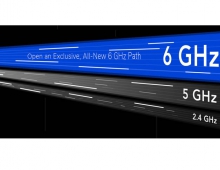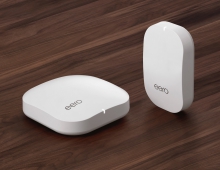
Wi-Fi Goes Mobile With Alcatel-Lucent
Alcatel-Lucent is integrating Wi-Fi with mobile networks with its lightRadio architecture, allowing users to move between the two networks and authenticate using the SIM card, the company said on Tuesday.
lightRadio Wi-Fi sorts through the confusion of hotspots and cellular networks to find and connect with the best available wireless broadband network, while helping communications service providers extend their reach by integrating Wi-Fi directly into their service offerings.
People like to be able to switch from 3G or 4G networks to Wi-Fi to access the Internet, particularly with the growing interest in Cloud-based applications to store music, video, photos and multimedia content. However, switching from a cellular service to a Wi-Fi network is not always seamless, particularly when it requires first finding a network and then getting through complex log-in and password procedures.
lightRadio Wi-Fi simplifies this process by allowing people to switch automatically from a cellular service to residential or public Wi-Fi networks and hotspots without having to login, worry about payments schemes, or even be aware of the shift. This is done in three ways: by using software that identifies and connects people to a 'trusted' network automatically; by introducing new capabilities into service provider networks to manage the transition between Wi-Fi and cellular networks; and by integrating Wi-Fi directly into small-cell base stations and cellular networks.
lightRadio Wi-Fi addresses another big concern - security. Many people prefer to connect to hotspots that they know they can trust, especially when accessing services and streamed content from the Cloud, or when they need uninterrupted connections for video streaming or video phone calls. lightRadio Wi-Fi always finds the most 'trusted' network.
lightRadio Wi-Fi represents a radical departure from the traditional way that mobile operators apply Wi-Fi: today it is often used to 'offload' traffic from congested cellular networks. By enabling cellular subscribers to stay within their network and service plan, it will allow service providers to maintain use of their services, creating revenue, independent of how the customer is connected.
The lightRadio Wi-Fi approach is also highly applicable for fixed-line and cable service providers, allowing them to extend wireless coverage to existing subscribers without investing in expensive spectrum or wireless infrastructure.
The lightRadio architecture uses slimmed-down base stations that can be placed almost anywhere. LightRadio Wi-Fi is comprised of the 7750 Service Router; new software for Alcatel-Lucent's policy manager, the 5780 Dynamic Services Controller; and femtocell or metrocell base stations with integrated Wi-Fi.
The 7750-gateway and the upgraded policy manager are both in trials now, and will start shipping in the next couple months. The metrocell base station with Wi-Fi will become available during the fourth quarter, according to Alcatel-Lucent.
Alcatel-Lucent is collaborating with several major Wi-Fi access point companies to ensure interoperability and is integrating Motorola Solutions' high-performance Wi-Fi solution and Qualcomm Atheros Wi-Fi technology into its multi-standard Metrocells.
People like to be able to switch from 3G or 4G networks to Wi-Fi to access the Internet, particularly with the growing interest in Cloud-based applications to store music, video, photos and multimedia content. However, switching from a cellular service to a Wi-Fi network is not always seamless, particularly when it requires first finding a network and then getting through complex log-in and password procedures.
lightRadio Wi-Fi simplifies this process by allowing people to switch automatically from a cellular service to residential or public Wi-Fi networks and hotspots without having to login, worry about payments schemes, or even be aware of the shift. This is done in three ways: by using software that identifies and connects people to a 'trusted' network automatically; by introducing new capabilities into service provider networks to manage the transition between Wi-Fi and cellular networks; and by integrating Wi-Fi directly into small-cell base stations and cellular networks.
lightRadio Wi-Fi addresses another big concern - security. Many people prefer to connect to hotspots that they know they can trust, especially when accessing services and streamed content from the Cloud, or when they need uninterrupted connections for video streaming or video phone calls. lightRadio Wi-Fi always finds the most 'trusted' network.
lightRadio Wi-Fi represents a radical departure from the traditional way that mobile operators apply Wi-Fi: today it is often used to 'offload' traffic from congested cellular networks. By enabling cellular subscribers to stay within their network and service plan, it will allow service providers to maintain use of their services, creating revenue, independent of how the customer is connected.
The lightRadio Wi-Fi approach is also highly applicable for fixed-line and cable service providers, allowing them to extend wireless coverage to existing subscribers without investing in expensive spectrum or wireless infrastructure.
The lightRadio architecture uses slimmed-down base stations that can be placed almost anywhere. LightRadio Wi-Fi is comprised of the 7750 Service Router; new software for Alcatel-Lucent's policy manager, the 5780 Dynamic Services Controller; and femtocell or metrocell base stations with integrated Wi-Fi.
The 7750-gateway and the upgraded policy manager are both in trials now, and will start shipping in the next couple months. The metrocell base station with Wi-Fi will become available during the fourth quarter, according to Alcatel-Lucent.
Alcatel-Lucent is collaborating with several major Wi-Fi access point companies to ensure interoperability and is integrating Motorola Solutions' high-performance Wi-Fi solution and Qualcomm Atheros Wi-Fi technology into its multi-standard Metrocells.




















